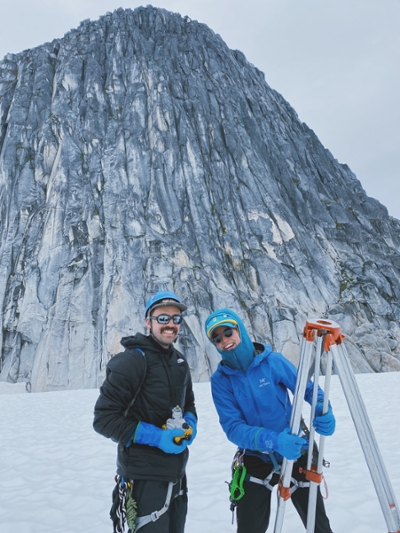A Polar Bear's Summer
By Tom PorterAs summer internships go, this was probably one of the more adventurous ones. Holly Harris ’22 spent two months traversing a glacier in Alaska, taking scientific measurements and carrying out groundbreaking research with leading glaciologists and climate scientists.
Harris is one of the more than ninety students who secured funding through the Office of Career Exploration and Development (CXD), enabling them to pursue summer internships or career-related projects of their choice by providing them with a generous stipend to live on. Fresh from her Alaskan adventure, the earth and oceanographic studies (EOS) major took time out to describe her experience.

Where exactly was your summer internship?
I spent the summer working as a student researcher for the Juneau Icefield Research Program (JIRP). The Juneau Icefield is located in the Coast Mountains of the Tongass National Forest and Atlin Provincial Park. The icefield covers an area the size of Rhode Island and includes around fifty outlet glaciers.
For over sixty years, JIRP has maintained the longest-running study of any glacier in the Western Hemisphere on the Taku, the largest glacier on the icefield. There are eleven permanent field stations and a dozen temporary camps located on the icefield, serving as the main sites from which the program bases its research.
What were you doing?
As a student researcher, I spent eight weeks traversing the Juneau Icefield on skis, learning the necessary mountaineering and navigation skills required along the way. Working with a team of leading glaciologists and climate scientists, I had the opportunity to participate in their groundbreaking research exploring all aspects of earth systems science. For me, this research included digging massive pits on various parts of the Taku glacier to document mass-balance (how much the glacier is retreating/advancing) and using a coring device to extract isotope samples.
"It is one thing to learn about Earth’s systems and the impacts of global warming in the classroom; it is another to move through and intimately connect with a landscape that is experiencing this rapid change."
Further, I learned how to set GPS way-points and fly drone surveys over nunataks (rock outcrops on the icefield) to collect images that could be processed using structure for motion in order to map the fracture density and orientation of the bedrock. In addition to the physical research, daily lectures and workshops provided context for the environment we studied. My experience learning in the best classroom imaginable—the icefield— reiterated for me a fascination and appreciation for Earth’s many intricate, interconnected, and fragile systems and helped me to understand the scale and speed at which glacial retreat is occurring due to climate change.



Why did you choose the program?
I chose to participate in JIRP because I was drawn to the program’s mission to bring together such an interdisciplinary team to approach scientific questions and brainstorm the means by which climate science can most effectively be communicated. Further, while it is one thing to learn about Earth’s systems and the impacts of global warming in the classroom, it is another to move through and intimately connect with a landscape that is experiencing this rapid change. JIRP provided me with this experience, which is one I look forward to sharing with my peers in the EOS department and one that will definitely impact my trajectory after Bowdoin.
Read about other Bowdoin summer interns who worked in the conservation/ecology field.